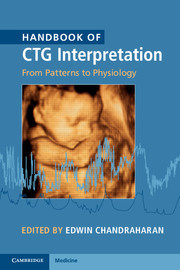Description
Handbook of CTG Interpretation
From Patterns to Physiology
Coordinator: Chandraharan Edwin
This highly practical manual promotes an evidence-based paradigm of fetal heart rate monitoring during labour.
Language: English
Subject for Handbook of CTG Interpretation:
Publication date: 02-2017
256 p. · 15.7x23.4 cm · Paperback
256 p. · 15.7x23.4 cm · Paperback
Description
/li>Contents
/li>Biography
/li>
This book promotes an evidence-based paradigm of fetal heart rate monitoring during labour, with a move away from the traditional 'pattern-based' interpretation to physiology-based interpretation. Chapters are presented in a systematic and accessible format, covering topics such as non-hypoxic causes of fetal brain injury, pre-existing hypoxia, types of intrapartum hypoxia, erroneous monitoring of maternal heart rate, fetal scalp blood sampling and fetal ECG (STAN), intermittent auscultation and medico-legal issues. Sections on 'pearls' and 'pitfalls' highlight good practice and common errors to promote best practice. End-of-chapter exercises allow the reader to engage with the theory and test their knowledge of key areas. This is a highly practical manual aimed at obstetricians and midwives, particularly those undergoing CTG training. The book will also be very useful to midwifery and medical students and to all those involved in multiprofessional intrapartum care.
List of contributors; Preface; Acknowledgment; Glossary; 1. 'An eye opener': perils of CTG misinterpretation. Lessons from confidential enquiries and medico-legal cases Edwin Chandraharan; 2. Physiology of fetal heart rate control and types of intrapartum hypoxia Anna Gracia-Perez-Bonfils and Edwin Chandraharan; 3. Fetal oxygenation Anna Gracia Perez-Bonfils and Edwin Chandraharan; 4. Understanding the CTG: technical aspects Harriet Stevenson and Edwin Chandraharan; 5. Applying fetal physiology to interpret CTG traces: predicting the NEXT change Edwin Chandraharan; 6. Avoiding errors: maternal heart rate Sophie Eleanor Kay and Edwin Chandraharan; 7. Antenatal cardiotocography Amar Bhide and Francesco D'Antonio; 8. Intermittent (intelligent) auscultation in the low risk setting Virginia Lowe and Abigail Archer; 9. Current scientific evidence on CTG Ana Piñas Carrillo and Edwin Chandraharan; 10. Role of uterine contractions and intrapartum re-oxygenation ratio Sadia Muhammad and Edwin Chandraharan; 11. Intrapartum monitoring of a preterm fetus Ana Piñas Carrillo and Edwin Chandraharan; 12. Role of chorioamnionitis and infection Jessica Moore and Edwin Chandraharan; 13. Meconium: why is it harmful? Leonie Penna; 14. Intrapartum bleeding Edwin Chandraharan; 15. Labour with a uterine scar: the role of CTG Ana Piñas Carrillo and Edwin Chandraharan; 16. Impact of maternal environment on fetal heart rate Ayona Wijemanne and Edwin Chandraharan; 17. Use of CTG with induction and augmentation of labour Ana Piñas Carrillo and Edwin Chandraharan; 18. Recognition of chronic hypoxia and the preterminal cardiotocograph Austin Ugwumadu; 19. Unusual fetal heart rate patterns: sinusoidal and saltatory patterns Madhusree Ghosh and Edwin Chandraharan; 20. Intrauterine resuscitation Abigail Spring and Edwin Chandraharan; 21. Management of prolonged decelerations and bradycardia Rosemary Townsend and Edwin Chandraharan; 22. ST-Analyser: case examples and pitfalls Sabrina Kuah and Geoff Matthews; 23. Role of a computerised CTG Sabrina Kuah and Geoff Matthews; 24. Peripheral tests of fetal wellbeing Charis Mills and Edwin Chandraharan; 25. ST-Analyser (STAN): principles and physiology Ana Piñas Carrillo and Edwin Chandraharan; 26. Operative interventions for fetal compromise Mary Catherine Tolcher and Kyle D. Traynor; 27. Non hypoxic causes of CTG changes Dovilė Kalvinskaitė and Edwin Chandraharan; 28. Neonatal implications of intrapartum fetal hypoxia Justin Richards; 29. Role of the anaesthetist in the management of fetal compromise during labour Anuji Amarasekara and Anthony Addei; 30. Medico-legal issues with CTG K. Muhunthan and Sabaratnam Arulkumaran; 31. Ensuring competency in intrapartum fetal monitoring: the role of GIMS Virginia Lowe and Edwin Chandraharan; 32. Physiology-based CTG training: does it really matter? Sara Ledger and Edwin Chandraharan; Index.
Edwin Chandraharan is Lead Consultant on the Labour Ward at St George's University Hospitals NHS Foundation Trust and Honorary Senior Lecturer at St George's Hospital Medical School, University of London.
© 2024 LAVOISIER S.A.S.




